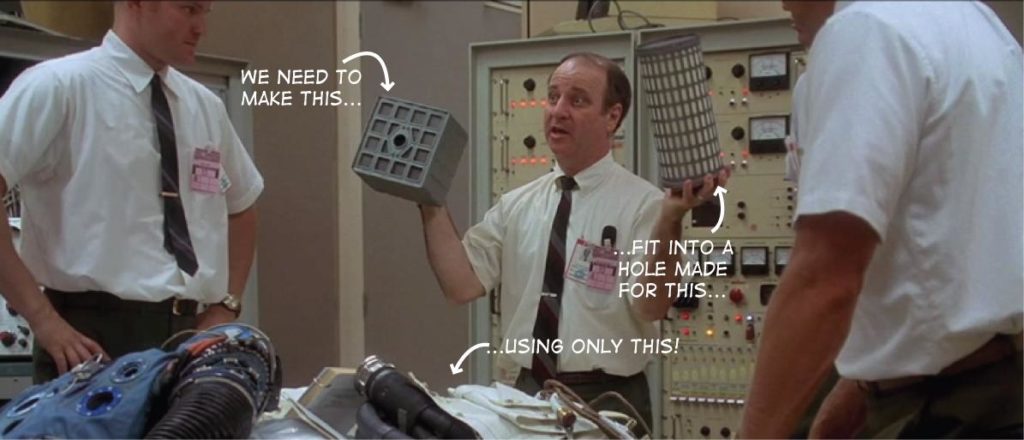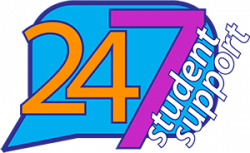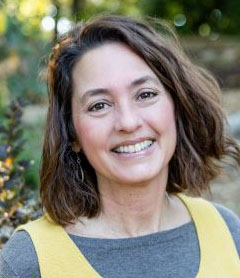
More than 20 years since I first watched “Apollo 13,” I’m often reminded of one particular scene.
And no, it’s not, “Houston, we have a problem.”
In order to save the Apollo crew, a group of NASA engineers raced against the clock to create a carbon dioxide filter from the limited equipment available in the spacecraft.
They quite literally had to figure out how to put a square peg in a round hole.
I love this scene because it required not only creative problem-solving skills but also teamwork under life-or-death stress. Watch it here.
After hearing Dr. Sandel and Dr. Monty Sullivan challenge us to work together on our enrollment and retention goals — to influence our future instead of being at the mercy of the trend lines — I was reminded once again of that dramatic “Apollo 13” scene.
Racing against the enrollment declines, I imagine our college sitting around a big table with the parts of VWCC spread around for all to examine … questioning and re-imagining their original purpose. How might we make the parts work better together … to help all of our students shoot for the moon?
Our budget isn’t the only potential casualty. The lives of our students — and our community — depend on the answers.
But before we explore some possible answers, we need to ask the right questions.
Dr. Sullivan’s presentation to the college on Jan. 4 was inspiring and chock full of ideas (loved the work ethic grades on transcripts!), but these are the five tough questions that got my attention:
(1) Would you send your child to Virginia Western? Why or why not? If not, what would change your answer?
(2) What makes Virginia Western special? What do we offer that is changing lives … or could be changing lives?
(3) We are not a university. How would we refine/re-imagine/redesign our role based on the changing needs of our community?
(4) Instead of exclusively focusing on the 4,459 high school graduates in the region, why don’t we better serve the 100,000 working adults with a high school diploma or less?
(5) Is your program in high demand in our region? How might we tweak the program to incorporate credentials that lead to better-paying jobs? What credentials would help people go from making $8 an hour to $15 an hour?
And if you don’t know what are considered high-demand jobs, you should read the Local Workforce Plan by Virginia’s Blue Ridge Works, paying closest attention to pages 3-19.
The plan identifies five existing target industries with high job growth:
- Healthcare
- Manufacturing
- Construction
- Transportation and warehousing
- Financial services
It also explains three emerging sectors, with a few shout-outs to Virginia Western:
- Food and beverage manufacturing
- Life sciences
- IT
You can drill into the wage data and credentialing requirements here:
https://vcwblueridge.com/wp-content/uploads/VBRW-Local-Plan_Final.pdf
I’m looking forward to our Retention Town Hall on Jan. 11 and future meetings to discuss our challenges together.
And while these ideas are percolating, don’t forget about a few grant opportunities that could help turn them into reality. If you’re wondering how you — an individual faculty or staff member — can effect change, a grant can be a first step.
(1) The Paul Lee Professional Development Grant ($2,500 for the summer) and the Paul Lee Workshop Mini-Grant ( $1,500 maximum). Deadline is Feb. 1.
(2) The Educational Foundation’s Innovation Grant applications ($10,000 maximum) are due March 30. (Details)
The grants office would be happy to talk through you ideas. Please note that all proposals must be reviewed by Virginia Western’s Office of Grant Development and Special Projects prior to submission. Please contact Marilyn Herbert-Ashton ( mherbert-ashton@virginiawestern.edu | 857-6372) or myself ( sseagle@virginiawestern.edu | 857-76084) for assistance.






 Shelley Lyons is glad to be back on campus as she is a Virginia Western alum, and has served as the Administrative Officer for Grants Administration at Virginia Western since early 2022. Prior to VWCC, her career focus was within the Human Services and Arts fields. She wrote her first grant in 1996 on a whim and has continued to plan and learn since that time. She most enjoys seeing a well-planned project come to fruition, where funder, project manager and beneficiaries can all feel success and see impact.
Shelley Lyons is glad to be back on campus as she is a Virginia Western alum, and has served as the Administrative Officer for Grants Administration at Virginia Western since early 2022. Prior to VWCC, her career focus was within the Human Services and Arts fields. She wrote her first grant in 1996 on a whim and has continued to plan and learn since that time. She most enjoys seeing a well-planned project come to fruition, where funder, project manager and beneficiaries can all feel success and see impact.